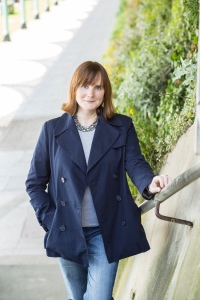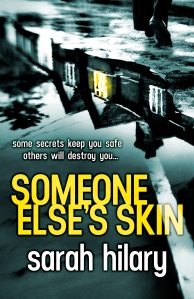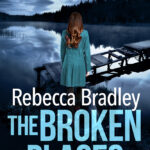 I’m thrilled to be able to welcome crime writer Sarah Hilary to the First Draft hot seat today.
I’m thrilled to be able to welcome crime writer Sarah Hilary to the First Draft hot seat today.
Sarah’s debut novel Someone Else’s Skin will be published in February by Headline in the UK on 27th February and Penguin in the US. On her blog profile, she boasts that the best advice she ever read in a butchers shop was ‘Please do not sit children on the bacon slicer. We are getting a little behind in our orders.’
When you decide to write something new, what is the first thing you do?
SH: The answer used to be: write. But I’ve learnt to let ideas grow a little in my head, to find the shape of the story before I try and put it down on the page.
Do you have a set routine approaching it?
SH: Not as such. I get a new manila Moleskine and make some rough notes, so that it feels real. In the back of the same notebook I start compulsively making lists of possible titles.
Pen and paper or straight to the keyboard?
SH: Straight to keyboard. My freehand isn’t fast enough, any longer.
How important is research to you?
SH:I need to have my facts straight, and for the story to feel authentic. But my first concern is the story: character and plot.
How do you go about researching?
SH: I like first person accounts, when I can lay my hands on them. And images, to help me visualise the world I’m creating.
How do you store everything; ideas, research, images that catch your eye?
SH: I bookmark pages so, yes. I’ve often wished I could sketch, to embellish my notes, but I can’t draw for toffee.
Tell us how that first draft takes shape?
SH: As quickly as I can make it happen. I try not to re-read as I’m writing that first draft, because I want it all down and I want the story to have momentum which is doesn’t tend to have if I keep re-reading and adding layers too soon. I like my first draft to be lean.
Are there any rituals you have to do or items you must have with you while writing that draft?
SH: Nope, unless you count making myself write a minimum of 2,000 words a day.
 Does the outside world exist or are you lost to us for a period of time as the magic works?
Does the outside world exist or are you lost to us for a period of time as the magic works?
SH: A bit of both. While I’m physically writing I’m still connected to the outside world. It’s when I’m away from the laptop that I tend to live inside my head – where the story is. That probably sounds a bit odd, doesn’t it?
What does your work space look like?
SH: Whichever café I’m in. A table, a chair and a laptop. And empty coffee cups (mine).
Edit as you go or just keep getting words out?
SH: Definitely the latter, otherwise it takes too long. Also, I like to surprise myself with bits I’d forgotten I’d written; if I can send a shiver up my spine then I reckon I’m onto a good thing.
I see many writers counting words in a day. Word counter or other method of keeping track of progression?
SH: I am obsessed with word count. There, I’ve said it. My daughter asked me how my new book was going a while back and I said, ‘Pretty good. Look, it’s 92,000 words,’ in response to which she gave me a pitying look and said, ‘Not the word count. The story…’ Guilty as charged.
So, that first draft is down. Roughly how long did it take? And what shape is it in?
SH: Three months, give or take. The latest one (Marnie Rome book two) was in pretty good shape. But that’s taken me over a million words, to get to the point where I can write a decent first draft.
In what format do you like to read it through, ereader, paper or the computer screen?
SH: Onscreen. I don’t have an ereader and am currently without a printer, so needs must…
What happens now that first draft is done?
SH: I try and sit on it for a while, like we’re supposed to. But in reality I’m usually up against a deadline so I’ll dive straight in from the start and see what sort of state it’s in. Editing starts straightaway, in other words.
Thanks for digging into the depths of the first draft. It’s been a pleasure having you.
SH: It’s been a pleasure being here. Thank you for inviting me over.
You can find Sarah on her blog or on Twitter.
Someone Else’s Skin, out 27th February!
To read any of the previous First Draft Q&A’s you can check the list Here.
To be a part of the First Draft series, just get in touch and let me know. Along with the answers to the questions, I’ll need a profile photograph, a first draft photograph and three links that you feel are your most important. Please don’t think I’m fully booked up, if you’re thinking about it – Get in touch! It’s been a great series so far, lets see where 2014 takes us!




So many writers talk about writing in cafes, I really want to try it… but in my local cafes, people would always want to talk to me! My 9 year old thinks word count is important. He looks over my shoulder and is always impressed at how many words I’ve written… I wish it could be that simple. Best of luck with your book, Sarah. And hello, Rebecca 🙂
Thank you! Your 9 year old sounds great. Good luck with your writing.
I don’t like for my first drafts to be lean, that’s just the way they turn out!
I watch word count as well, but I’ve only hit a two thousand word day twice. And I won’t tell you how many hours that took.
Nice to meet you, Sarah!
Thanks, Alex, you too. I have limited writing days, so try and pin myself to my chair until I’ve done my target words. It’s tough, though, you’re right.
Rebecca – Thank you for hosting Sarah.
Sarah – I know what you mean about letting the story take shape before you write it. I like that kind of structure too. And I agree: characters are so important to a story. I completely understand your focus on them. I wish you much success.
Thank you, Margot!
Interesting interview – and it’s always reassuring to find that other writers have some of the same habits as I do! I’m off to check out the book!
Thanks, Linda!
Thanks again, Rebecca, for inviting me over and asking me to examine my first draft process – it was an interesting exercise!